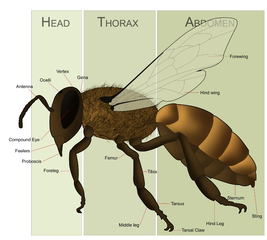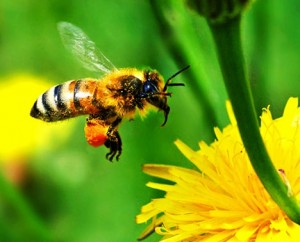 The worker honey bee has several important glands situated in her head, thorax and abdomen. Starting just inside the bee’s mouth are the opening points of two very large glands, these are called the
hypopharyngeal
glands. The hypopharyngeal glands are crucial to the honey bee and to the survival of the colony.
The worker honey bee has several important glands situated in her head, thorax and abdomen. Starting just inside the bee’s mouth are the opening points of two very large glands, these are called the
hypopharyngeal
glands. The hypopharyngeal glands are crucial to the honey bee and to the survival of the colony.
These glands are made up of a number of secretory cells clustered around a central canal. When the honey bee is young, in the first few weeks of its life, these cells are round and plump and produce brood food, a form of bee milk which is used to feed bee larvae. As the bee gets older and becomes a forager at about three weeks old, these cells become smaller and much reduced in size. The hypopharyngeal glands have now switched from producing brood food to producing invertase, which as the name suggests inverts sugars. However if necessary for the needs of the colony the worker bee can switch back to producing bee food from these glands.
In addition a pair of glands in the mandibles secrete a type of preservative which is mixed with the brood food as it is secreted from the hypopharyngeal glands, this has anti bacterial qualities which prevents the food from deteriorating.
The mandibular glands also produce an alarm scent called heptanone which is used to alert other bees to danger. This is one of the reasons that beekeepers use a smoker as the smoke masks this scent and reduces the likelihood of the bees orchestrating an attack. The mandibular glands in the queen bee produce a type of fatty acid which is called ‘queen substance’ which is used to ensure the workers are aware of her presence.
Moving down the body there are two salivary glands in the head and thorax, with openings on either side of the bee’s tongue. Their liquid secretion is used to dilute honey and dissolve sugar crystals.
On the upper side of the abdomen of the bee on the last visible segment is the Nasanov gland. This releases a pheromone which is used to attract members of the colony who might have lost the location of their hive. Often you will notice bees at the entrance of a hive fanning with their wings to propel the airborne scent to the bees flying around, especially when the hive has been disturbed.
Worker bees also have four pairs of wax glands on the underside of the last five segments of their abdomens. Wax is secreted into pockets underneath each gland and quickly solidifies into translucent white blobs which are then removed by mouth and worked on to use to build comb as required (see How and why bees produce wax ).
Finally there are two glands associated with the bee’s stinging mechanism. There is a long thin venom gland which produces the acidic venom which is contained in the venom sac. The second sting gland produces an alkaline solution which is thought to act as a lubricant for the stinging mechanism.
More Bee Anatomy and Physiology

